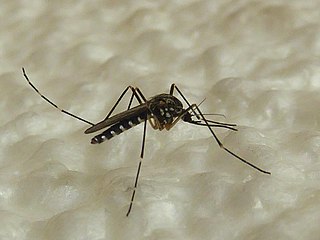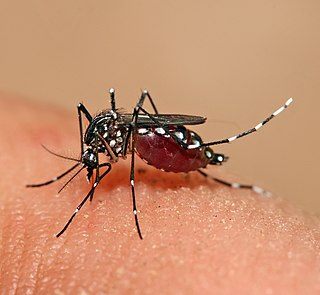
Aedes albopictus, from the mosquito (Culicidae) family, also known as the (Asian) tiger mosquito or forest mosquito, is a mosquito native to the tropical and subtropical areas of Southeast Asia. In the past few centuries, however, this species has spread to many countries through the transport of goods and international travel. It is characterized by the white bands on its legs and body.

Aedes aegypti, the yellow fever mosquito, is a mosquito that can spread dengue fever, chikungunya, Zika fever, Mayaro and yellow fever viruses, and other disease agents. The mosquito can be recognized by black and white markings on its legs and a marking in the form of a lyre on the upper surface of its thorax. This mosquito originated in Africa, but is now found in tropical, subtropical and temperate regions throughout the world.
Stegomyia is a large subgenus of the mosquito genus Aedes with 131 species classified in six species groups, two groups of which are further divided into subgroups.

Aedes pembaensis is a mosquito.

Aedes canadensis, the woodland pool mosquito, is an aggressive, day biting mosquito that can be a vector of a number of diseases which is found mainly in eastern North America.

The 2007 Yap Islands Zika virus outbreak represented the first time Zika virus had been detected outside Africa and Asia. It occurred in the Yap Islands, an island chain in the Federated States of Micronesia. Zika virus (ZIKV) is a vector-borne flavivirus in the same family as yellow fever, dengue, West Nile and Japanese encephalitis viruses.
Aedes africanus is a species of mosquito that is found on the continent of Africa with the exclusion of Madagascar. Aedes aegypti and Aedes africanus are the two main yellow fever vector species in Zambia. Aedes africanus is mainly found in tropical forests not near wetlands.
Aedes apicoargenteus is an African mosquito species, first described as Stegomyia apicoargentea from specimens collected in Ashanti, Ghana.
Aedes vittatus is a species of mosquito that was first described in 1861 as Culex vittatus from specimens collected on Corsica. In 2000, the species was transferred to the newly erected subgenus Fredwardsius as the type species representing the subgenus.
Aedes furcifer was named in 1913 as a nomen novum for nigra (Theobald). Aedes furcifer and Aedes taylori have been treated as two species, usually found sympatrically, but are difficult to separate morphologically so the term "Aedes furcifer-taylori group" has been used for the two species, and they have not always been differentiated by workers conducting studies on them.
Aedes luteocephalus is an African species that is a demonstrated or suspected vector of several important arboviral diseases of humans. First described in 1907 as Stegomyia luteocephala, the species is currently classified in the genus Aedes, subgenus Stegomyia.
Aedes malayensis was first described in 1963 by Australian entomologist Donald Henry Colless as a subspecies of Aedes scutellaris from males collected at Pulau Hantu, Keppel Harbor, Singapore. In 1972 the subspecies was elevated to species status by Yiau-Min Huang, although the move was disputed by the original describer on biological as opposed to morphological principles.
Aedes cordellieri is a sub-Saharan African species of mosquito suspected of being a vector of yellow fever. The species name honors Dr. Roger Cordellier, a former medical entomologist with Office de la Recherche Scientifique et Technique Outre-Mer (ORSTOM) in Ivory Coast, in recognition of his contributions to the knowledge of the mosquito fauna of Africa.

Aedes koreicus, the Korean bush mosquito is a species of mosquito in the genus Aedes. The adults are relatively large with a black and white pattern on their legs and other body parts. Clear longitudinal lines on the dorsal part of the thorax distinguish it from Ae. aegypti and Ae. albopictus. The species bears close morphological, ecological, and genetic similarity to the Asian bush mosquito, Aedes japonicus, but can be physically distinguished by a pale basal band on the hind tarsomere.

Aedes japonicus, commonly known as the Asian bush mosquito or the Asian rock pool mosquito, was first described by Theobald in 1901 from Tokyo, Japan. They are competent arbovirus vectors known to transmit the West Nile virus as well as Japanese and St. Louis encephalitis. They are listed as an invasive species by the Global Invasive Species Database.

Aedini is a mosquito tribe in the subfamily Culicinae. It is the main tribe of mosquitoes with 1256 species classified in 81 genera and two groups incertae sedis.
Aedes (Neomelaniconion) lineatopennis is a species complex of zoophilic mosquito belonging to the genus Aedes. It is found in Oriental Regions such as India, Sri Lanka, and also in Eastern & Southern Africa, Nigeria, Japan, Malaysia, and Australia. Female has a wing length of 4 to 5mm. Head scales golden, curved and narrow. Male with tentacles over long beak, distal with wool.

Aedes taeniorhynchus, or the black salt marsh mosquito, is a mosquito in the family Culicidae. It is a carrier for encephalitic viruses including Venezuelan equine encephalitis and can transmit Dirofilaria immitis. It resides in the Americas and is known to bite mammals, reptiles, and birds. Like other mosquitoes, Ae. taeniorhynchus adults survive on a combination diet of blood and sugar, with females generally requiring a blood meal before laying eggs.

Aedes scapularis is a species of mosquito primarily found in neo-tropical regions of the Americas.

Ellinor Catherine Cunningham van Someren was a Ugandan-born British medical entomologist. She specialised in mosquitoes, identifying at least thirty-three new species while employed by the Kenyan Health Service and partaking in scientific surveys in Kenya, Tanzania, and Somalia. In 1962, she was a consultant on yellow fever to the World Health Organization. Van Someren was appointed an Officer of the Order of the British Empire in the Queen's Birthday Honours in 1974 for diplomatic services in scientific research overseas.










